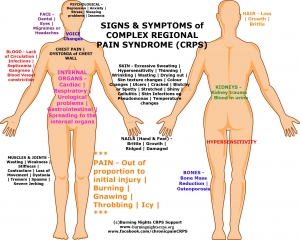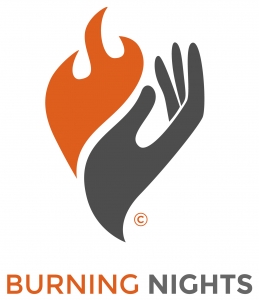Complex Regional Pain Syndrome (CRPS) is a chronic condition that causes severe and hard to relieve pain. It commonly affects one of the limbs – arms, legs, hands or feet, but sometimes whole limbs can be affected.
It usually occurs following an injury or trauma to part of the body i.e. broken bone, sprain, burn or surgery. Most people recover from an injury without experiencing any significant long term effects, but people with CRPS develop long term pain. The pain that follows the injury is not reflective of the original injury sustained and is often considered far worse than the original injury itself.
Symptoms of Complex Regional Pain Syndrome (CRPS)
The main characteristics are:
- Prolonged and very severe pain – this may be burning, throbbing, stabbing or stinging pain
- Changes in skin colour or temperature – skin may appear red or blue in colour or mottled
- Swelling or perceived swelling in the affected area
- The affected limb can be very sensitive even to light touch
- Stiffness in the affected limb
- Changes in hair growth and nail growth
- The affected limb can feel ‘larger’ or ‘smaller’ than usual
- Negative feelings about the affected limb
- Symptoms of CRPS usually start within a month of the original injury
- People with CRPS can become very concerned, anxious or depressed – this can be the case with anyone with a long-term illness or chronic pain
Causes of CRPS
CRPS is believed to be caused by damage to, or malfunction of, the peripheral and central nervous systems. The exact cause is unclear, but often a fracture of a limb or surgical intervention can act as a trigger. The pain lasts long after the original injury has healed and often covers a larger area. In very rare cases, complex regional pain syndrome can occur without any evident trigger.
CRPS affects both men and women but is more common in females. It is rare in children but is not so uncommon in teenagers.
Diagnosis of CRPS
CRPS is relatively rare, but research shows that treatment is more likely to be effective if introduced as early as possible and significantly in the early stages of the disease.
Like many syndrome type conditions, there is no specific test to confirm Complex Regional Pain Syndrome (CRPS). Doctors will assess each patient on a case by case basis by conducting a physical examination which can include diagnostic tests to rule out other causes of the symptoms. These may include:
- Ultrasound scans
- Budapest Criteria
- MRI scans
- Blood tests – to rule out infection or autoimmune conditions such as rheumatoid arthritis
Treatment of CRPS
Treatment for CRPS sufferers is usually a multidisciplinary approach using a combination of treatments including multi-modal pain medication and treatment including physical rehabilitation, and psychological support for managing the pain and coping strategies. Treatment plans should be tailored to each individual, as no patient will respond to the same treatment pathway.
Rehabilitation – A key element of CRPS treatment is movement. This helps patients to stay mobile and retain as much of their normal activities as possible and restore function. It also helps retain muscle strength. The earlier a physiotherapy based rehabilitation programme is started, the better.
Rehabilitation won’t necessarily stop the pain, but it can help retain normal function, reduce muscle wastage and prevent secondary problems. It’s best to start with a graded exercise programme starting very gently and working up to more challenging exercises to prevent a flare-up of pain.
Medication – There is no specific medication for CRPS, however, several pain medications are often used alone or in combination to help target the pain for CRPS sufferers. This often includes neuropathic medication, anticonvulsants, analgesics, opioids, antidepressants, local anaesthetic patches or injections. Often these medications help with the pain, which then allows a patient to begin the physical therapy.
Psychological therapies – It is important to understand that CRPS is not in the patient’s mind, however chronic pain conditions can influence their frame of mind. There are also techniques to help patients manage their pain and increase coping strategies. Mindfulness techniques can be helpful in managing the stress and emotions that often accompany chronic conditions.
A treatment plan may also include:
Exercise – Little and often is best, to avoid exacerbation of pain. Swimming and walking are good low-impact exercises that will maintain strength and function without putting too much pressure on the affected area.
Diet – A healthy, balanced diet is important anytime, however it is thought that higher levels of vitamin C can help prevent CRPS from developing and can help in the early stages of CRPS.
Work – Depending on the severity of the CRPS, it may be worth considering some alterations to the working environment, equipment or hours. A work assessment should ideally be arranged for this.
TENS – Transcutaneous electrical nerve stimulation is the use of electric current produced by a device to stimulate the nerves for therapeutic purposes.
Hydrotherapy – Hydrotherapy involving warm water immersion and exercise.
Spinal Cord Stimulation – This treatment method is often one the last in the plan if other treatments have not been effective.
Contact us now for advice regarding your case
Contact the Burning Nights Charity for support http://www.burningnightscrps.org/crps-rsd-support/ 
Latest Updates
- Psychiatrist joins Medicolegal Partners team We are pleased to announce that Dr Priscilla Kent has joined our team of medicolegal…19 Dec 2024
- A Medicolegal Perspective on Cervical Spine Injuries The cervical spine comprises the bones that make up the neck. Injuries to this area…11 Nov 2024
- A Medicolegal Perspective on Birth Injuries Involving Nerve Damage and Scarring A birth injury is defined as any structural damage and/or functional deterioration that occurs in…11 Nov 2024
- The Medicolegal Implications of Hindsight Bias In the context of clinical medicine, bias is the predisposition to form premature or undue…23 Sep 2024
